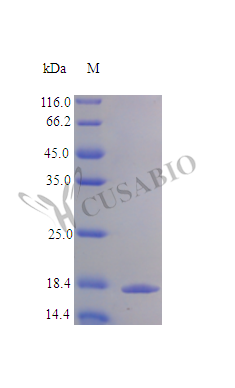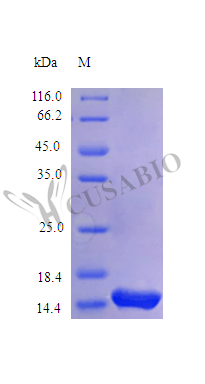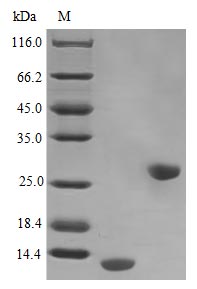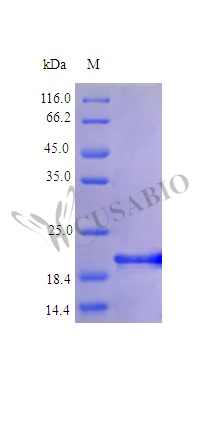Recombinant Human Claudin-6 (CLDN6), partial
In Stock-
货号:CSB-CF005508HU
-
规格:¥7410
-
图片:
-
其他:
产品详情
-
纯度:Greater than 90% as determined by SDS-PAGE.
-
基因名:CLDN6
-
Uniprot No.:
-
别名:CLDN6; UNQ757/PRO1488; Claudin-6; Skullin
-
种属:Homo sapiens(Human)
-
蛋白长度:Partial
-
来源:in vitro E.coli expression system
-
分子量:24.8kDa
-
表达区域:1-82aa
-
氨基酸序列MASAGMQILGVVLTLLGWVNGLVSCALPMWKVTAFIGNSIVVAQVVWEGLWMSCVVQSTGQMQCKVYDSLLALPQDLQAARA
Note: The complete sequence including tag sequence, target protein sequence and linker sequence could be provided upon request. -
蛋白标签:N-terminal 6xHis-SUMO-tagged
-
产品提供形式:Liquid or Lyophilized powder
Note: We will preferentially ship the format that we have in stock, however, if you have any special requirement for the format, please remark your requirement when placing the order, we will prepare according to your demand. -
缓冲液:Lyophilized from Tris/PBS-based buffer, 6% Trehalose, pH 8.0
-
储存条件:Store at -20°C/-80°C upon receipt, aliquoting is necessary for mutiple use. Avoid repeated freeze-thaw cycles.
-
保质期:The shelf life is related to many factors, storage state, buffer ingredients, storage temperature and the stability of the protein itself.
Generally, the shelf life of liquid form is 6 months at -20°C/-80°C. The shelf life of lyophilized form is 12 months at -20°C/-80°C. -
货期:3-7 business days
-
注意事项:Repeated freezing and thawing is not recommended. Store working aliquots at 4°C for up to one week.
-
产品描述:
This recombinant HumanCLDN6 protein is an in vitro E.coli (cell-free) expressed partial protein. Its purity is 90%+ determined by SDS-PAGE. Cell-free protein expression is the in vitro synthesis of a protein using translation-compatible extracts of whole cells. In principle, whole-cell extracts contain all the macromolecules and components needed for transcription, translation, and even post-translational modification. These components include RNA polymerase, regulatory protein factors, transcription factors, ribosomes, and tRNA. When supplemented with cofactors, nucleotides, and the specific gene template, these extracts can synthesize proteins of interest in a few hours.
CLDN6 is a tight junction molecule that participates in cell-to-cell adhesion of epithelial or endothelial cell sheets and maintains cell integrity. CLDN6 is important for the formation of barriers, especially the lung epithelial barrier and the epidermal permeability barrier (EPB), which prevent solutes and water from freely traversing through the extracellular space. CLDN6 is abnormally expressed in numerous malignancies such as ovarian cancer and testicular cancer and is implicated in cancer initiation, proliferation, apoptosis, migration, invasion, and progression. Its abnormal expression is also associated with Hepatitis C infection. -
Datasheet & COA:Please contact us to get it.
相关产品
靶点详情
-
功能:Plays a major role in tight junction-specific obliteration of the intercellular space.; (Microbial infection) Acts as a receptor for hepatitis C virus (HCV) entry into hepatic cells.
-
基因功能参考文献:
- Antibodies recognizing native CLDN6 as displayed on cell surfaces and mediating complement-dependent cytotoxicity were elicited in vaccinated animals. The data suggest applications of CLDN6 displaying Virus-like particles in cancer immunotherapy. PMID: 29131519
- these results suggest that Helicobacter pylori lipopolysaccharide induces TLR2 expression in the gastric adenocarcinoma cells, and that the longer the exposure to lipopolysaccharide, the greater the expression of TLR2 in the cell membrane; consequently the expression of claudin-4, -6, -7 and -9 also increases PMID: 29031421
- Study provides evidence that high expression of CLDN6 confers chemoresistance on breast cancer which is mediated by GSTP1, the activity of which is regulated by p53. PMID: 29116019
- CLDN6 enhances the chemoresistance to ADM via activating the AF-6/ERK signaling pathway and up-regulating cancer stem cell characters in MDAMB231 cells. PMID: 29159771
- we demonstrated that the downregulation of CLDN6 is regulated through promoter methylation by DNMT1, which depends on the SMAD2 pathway, and that CLDN6 is a key regulator in the SMAD2/DNMT1/CLDN6 pathway to inhibit EMT, migration and invasion of breast cancer cells PMID: 28867761
- In conclusion, this information from bioinformatics analysis will help future attempts to better understand CLDN6 regulation and functions. PMID: 28656265
- high expression of CLDN 6 was observed in approx. 65% of the myxofibrosarcomas, whereas the benign soft tissue tumors did not show a high expression of CLDN 6. The expression of CLDN 6 in the myxofibrosarcomas was significantly higher than those of other tumor specimens. Among the myxofibrosarcomas, the high expression of CLDN 6 was correlated with high FNCLCC grades and high AJCC stages. PMID: 28476380
- Results show that DNA methylation down-regulates CLDN6 expression through MeCP2 binding to the CLDN6 promoter, deacetylating H3 and H4, and altering chromatin structure, consequently promoting migratory and invasive phenotype in breast cancer cells. PMID: 27461117
- Cldn6 was decreased in alveolar type II-like epithelial cells (A549) and primary small airway epithelial cells when exposed to cigarette smoke ext PMID: 27982694
- suggest that claudin-6 induces MMP-2 activation through claudin-1 membrane expression PMID: 27914788
- Data show that claudin-6 (CLDN6) R209Q and occludin (OCLN) P24A mutations do not affect HCV pseudoparticles (HCVpp) entry. PMID: 26561856
- The expression of ASK1 is correlated with the level of claudin-6 in cervical carcinoma cells and tissues. PMID: 26191261
- High levels of CLDN6 are associated with non-small-cell lung cancer. PMID: 24710653
- The expression of claudin-6 was down regulated in gastric cancer tissue. PMID: 23919729
- Only some hepatitis C virus strains efficiently use CLDN6 for infection. PMID: 23775920
- This work provides a proof of concept for the use of Claudin-6 to eliminate residual undifferentiated human pluripotent stem cells from culture. PMID: 23778593
- Although claudin-6 and claudin-9 can serve as entry factors in cell lines, hepatitis C virus infection into human hepatocytes is not dependent on claudin-6 and claudin-9. PMID: 23864633
- ASK1 signal may play a positive role in the inhibitory effect of claudin-6 in breast cancer. PMID: 22925655
- Our results show that claudin-6 protein is significantly down-regulated in breast invasive ductal carcinomas PMID: 22455563
- CLDN6 is not a specific biomarker for atypical teratoid rhabdoid tumors as it is expressed in a variety of other pediatric CNS and soft tissue tumors. PMID: 21989342
- 17beta-E2 might regulate the expression of claudin-6 and inhibit the proliferation and migration of MCF-7 cells. PMID: 20388399
- Increased expression of claudin-6, claudin-7, or claudin-9 is sufficient to enhance tumorigenic properties of a gastric adenocarcinoma cell line. PMID: 20874001
- CLDN6 may be a useful positive marker to help further identify atypical teratoid/rhabdoid tumors for diagnostic and treatment purposes PMID: 19220299
- Claudins 6, 7, and 9 expressions are closely related to gastric carcinogenesis PMID: 19960275
- The up-regulation of claudin-6 expression in MCF-7 breast cancer cells suppresses their malignant phenotypes with a correlation with the restoration of tight junction integrity. PMID: 20367941
- claudin-6, downregulates the malignant phenotype of breast carcinoma. PMID: 20215972
- Claudin 6 was not found in epithelioid glioblastomas or rhabdoid glioblastomas. PMID: 20118769
- CLDN6 and CLDN9, but not CLDN1, are expressed in peripheral blood mononuclear cells, an additional site of HCV replication. PMID: 17804490
- claudin-6 and claudin-9 expressed in CD81+ cells also enable the entry of HCV pseudoparticles derived from six of the major genotypes. PMID: 18234789
- CLDN6, clustered with CLDN9 at human chromosome 16p13.3, is a four-transmembrane protein with WWCC motif, defined by W-X(17-22)-W-X(2)-C-X(8-10)-C. PMID: 12736707
显示更多
收起更多
-
亚细胞定位:Cell junction, tight junction. Cell membrane; Multi-pass membrane protein.
-
蛋白家族:Claudin family
-
组织特异性:Expressed in the liver, in peripheral blood mononuclear cells and hepatocarcinoma cell lines.
-
数据库链接:
Most popular with customers
-
Recombinant Human Interleukin-1 alpha protein (IL1A)
Express system: E.Coli
Species: Homo sapiens (Human)
-
Recombinant Human Interleukin-1 beta protein (IL1B)
Express system: E.Coli
Species: Homo sapiens (Human)
-
-
-
-
-
-

















